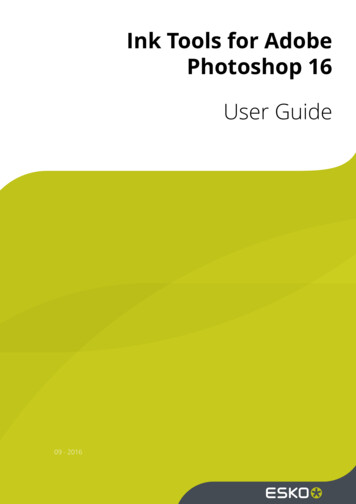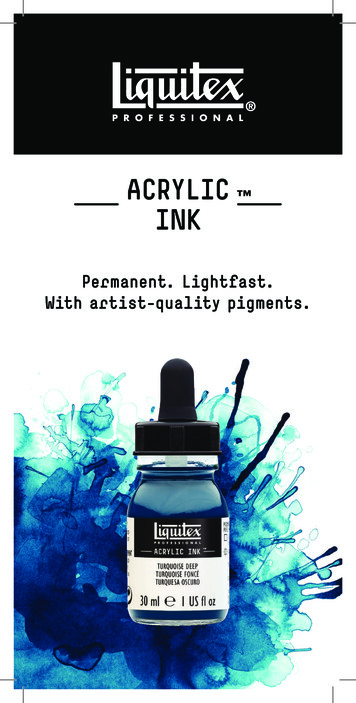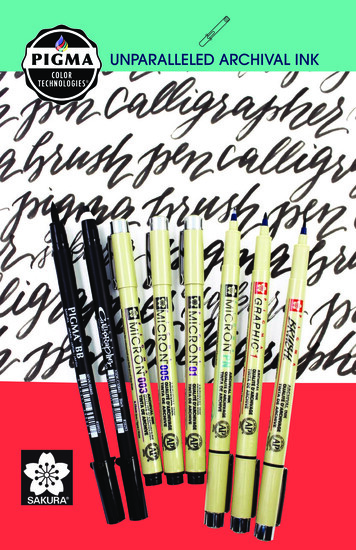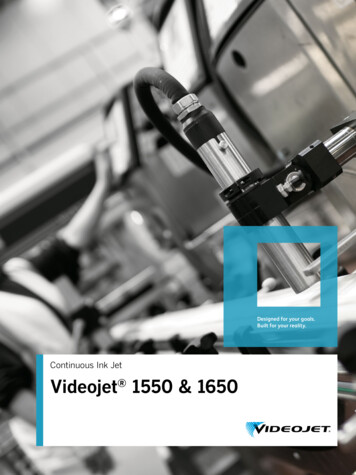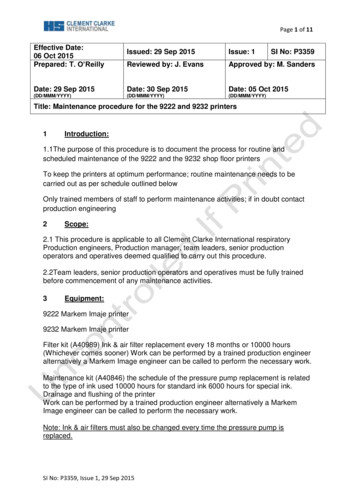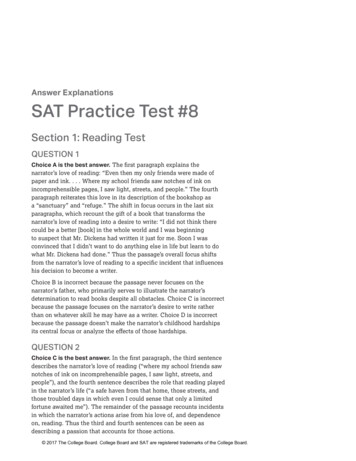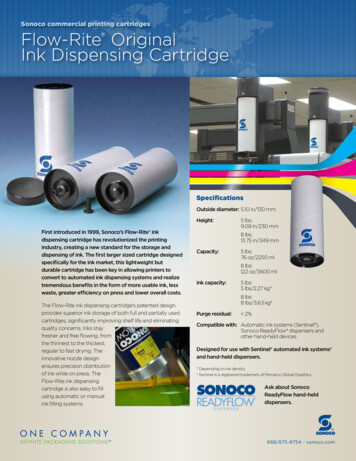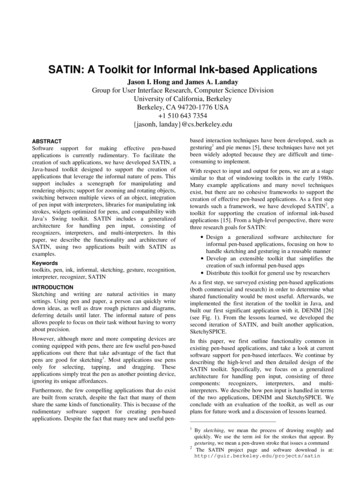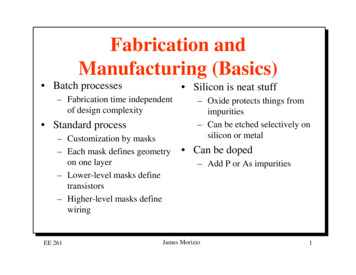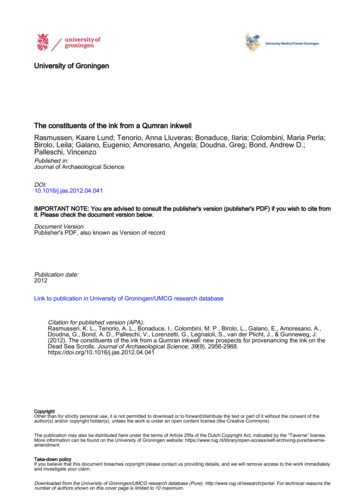
Transcription
University of GroningenThe constituents of the ink from a Qumran inkwellRasmussen, Kaare Lund; Tenorio, Anna Lluveras; Bonaduce, Ilaria; Colombini, Maria Perla;Birolo, Leila; Galano, Eugenio; Amoresano, Angela; Doudna, Greg; Bond, Andrew D.;Palleschi, VincenzoPublished in:Journal of Archaeological ScienceDOI:10.1016/j.jas.2012.04.041IMPORTANT NOTE: You are advised to consult the publisher's version (publisher's PDF) if you wish to cite fromit. Please check the document version below.Document VersionPublisher's PDF, also known as Version of recordPublication date:2012Link to publication in University of Groningen/UMCG research databaseCitation for published version (APA):Rasmussen, K. L., Tenorio, A. L., Bonaduce, I., Colombini, M. P., Birolo, L., Galano, E., Amoresano, A.,Doudna, G., Bond, A. D., Palleschi, V., Lorenzetti, G., Legnaioli, S., van der Plicht, J., & Gunneweg, J.(2012). The constituents of the ink from a Qumran inkwell: new prospects for provenancing the ink on theDead Sea Scrolls. Journal of Archaeological Science, 39(9), 1CopyrightOther than for strictly personal use, it is not permitted to download or to forward/distribute the text or part of it without the consent of theauthor(s) and/or copyright holder(s), unless the work is under an open content license (like Creative Commons).The publication may also be distributed here under the terms of Article 25fa of the Dutch Copyright Act, indicated by the “Taverne” license.More information can be found on the University of Groningen website: ing-pure/taverneamendment.Take-down policyIf you believe that this document breaches copyright please contact us providing details, and we will remove access to the work immediatelyand investigate your claim.Downloaded from the University of Groningen/UMCG research database (Pure): http://www.rug.nl/research/portal. For technical reasons thenumber of authors shown on this cover page is limited to 10 maximum.
Journal of Archaeological Science 39 (2012) 2956e2968Contents lists available at SciVerse ScienceDirectJournal of Archaeological Sciencejournal homepage: http://www.elsevier.com/locate/jasThe constituents of the ink from a Qumran inkwell: new prospects forprovenancing the ink on the Dead Sea ScrollsKaare Lund Rasmussen a, *, Anna Lluveras Tenorio b, Ilaria Bonaduce b, Maria Perla Colombini b,Leila Birolo c, Eugenio Galano c, Angela Amoresano c, Greg Doudna d, Andrew D. Bond a,Vincenzo Palleschi e, f, Giulia Lorenzetti e, g, Stefano Legnaioli e, Johannes van der Plicht h, i, Jan Gunneweg jaInstitute of Physics, Chemistry and Pharmacy, University of Southern Denmark, Campusvej 55, DK-5230 Odense M, DenmarkDipartimento di Chimica e Chimica Industriale, Via Risorgimento 35, 56126 Pisa, ItalyDipartimento di Chimica Organica e Biochimica, Università degli Studi di Napoli Federico II, Napoli, Via Cinthia, I-80127, ItalydColumbia College, 13910 45th Avenue NE #802, Marysville, WA 98271, USAeInstitute of Chemistry of Organometallic Compounds of CNR, Applied Laser Spectroscopy Laboratory (ALS-ICCOM), Area della Ricerca del CNR, Via G. Moruzzi 1, I-56124 Pisa, ItalyfUniversity of Pisa, Department of Archaeology, Via Galvani 1, Pisa, ItalygUniversity of Florence, Department of Chemistry, Via della Lastruccia 1, Sesto Fiorentino, ItalyhCenter for Isotope Research, Nijenborgh 4, 9747 AG Groningen, The NetherlandsiFaculty of Archaeology, Leiden University, P.O. Box 9515, 2300 RA Leiden, The NetherlandsjInstitute of Archaeology, Hebrew University of Jerusalem, Mount Scopus, 91905 Jerusalem, Israelbca r t i c l e i n f oa b s t r a c tArticle history:Received 4 December 2011Received in revised form13 March 2012Accepted 11 April 2012A unique sample of ink from an inkwell in the Schøyen Collection allegedly found at Qumran has beensubjected to analyses by several analytical techniques: GCeMS, proteomic analysis, PXRD, Raman, (ATR)FT-IR, LIBS, ICP-MS and MS. The results reveal to an unexpected level of detail how the ink was manufactured, which gives insight into the industrial processes and craftsmanship that were practiced at theQumran settlement during the Second Temple period (100 BCEeCE 70). The identified minerals andother organic and inorganic materials are sufficiently multiple and diverse that it is probable that thisspecific ink can be recognized if analyses of inks are performed on manuscripts from Qumran andother locations in Israel and the Middle East. The present work exposes a distinct and uniquepossibility to shed light on early Jewish manuscript controversies, including their provenance.Ó 2012 Elsevier Ltd. All rights ICP-MSProteomic analysesRadiocarbon dating1. IntroductionIn 1947e1955 a large quantity of fragmentary scrolls fromapproximately two thousand years ago was found in caves aroundQumran near to the Dead Sea east of Jerusalem, amounting to over* Corresponding author. Tel.: þ45 28713709.E-mail addresses: klr@sdu.dk (K.L. Rasmussen), ci.unipi.it(I.Bonaduce),perla@dcci.unipi.it(M.P. Colombini), birolo@unina.it (L. Birolo), eugenio.galano@unina.it (E. Galano),angela.amoresano@unina.it (A. Amoresano), gdoudna@msn.com (G. Doudna),adb@sdu.dk (A.D. Bond), vincenzo.palleschi@cnr.it (V. Palleschi), a lorenzetti@hotmail.com (G. Lorenzetti), stefano.legnaioli@pi.iccom.cnr.it (S. Legnaioli),J.van.der.Plicht@rug.nl (J. van der Plicht), jan.gunneweg@huji.ac.il (J. Gunneweg).0305-4403/ e see front matter Ó 2012 Elsevier Ltd. All rights reserved.doi:10.1016/j.jas.2012.04.041nine hundred ancient Jewish, biblical and sectarian texts. Threequarters of the texts were found in one cave, Cave 4, which canbe accessed only from the site of Khirbet Qumran, thereby raisingthe question of whether the scrolls were actually written at the site.Due to the variety of kinds of scrolls and scribal hands, it has longbeen accepted that many of the scrolls must have been imported.However, following the interpretation of the excavator, Roland deVaux (e.g. de Vaux, 1973), most scholars working on the texts todaybelieve that at least some were written by the Qumran residents.While this seems plausible, it has so far remained unproven.No scraps of parchment were found at the siteda factcommonly attributed to destruction by fire and/or water overtimedbut de Vaux reported finding three inkwells, two made of
K.L. Rasmussen et al. / Journal of Archaeological Science 39 (2012) 2956e2968clay and one made of bronze. Two of the inkwells were found inlocus 30, commonly referred to as the “scriptorium” (Fig. 1), andone was found in an immediately adjacent room (Nir-El and Broshi,1996). One further inkwell was found by another excavator ofQumran, Solomon Steckoll, in 1966e1967 (Steckoll, 1968, 1969;Goranson, 1993), and a fifth inkwell said to be from Qumran wasbought by a private person in 1967 from Kando (Khalil EskanderShahin), the antiquities dealer who also bought many of the DeadSea Scrolls from the Bedouin (Goranson, 1992: 39). In 1994, StephenGoranson published a sixth inkwell identified as coming fromQumran in the private antiquities collection of Martin Schøyen ofOslo (Goranson, 1994). This last inkwell (Fig. 2), referred to here asthe Schøyen inkwell, is the subject of our present study.Goranson reported that the Schøyen inkwell is “made of bronzeand has two handles on top that turn in opposite directions. It isa little over three inches (ca 8 cm) high and the same in diameter.Its shape, however, differs from the other known Qumran inkwells”(1994: 39). According to Schøyen, “this inkwell was discovered inthe Qumran ruins by Bedouin of the Ta’amireh tribe in about 1950,after the Qumran Cave 1 scrolls had come to light, but beforeRoland de Vaux began excavating the ruins in 1951”. According toGoranson Kando confirmed this account in 1993. Goranson notedthat the number of inkwells found at Qumran is unusually highcompared to reported results from other excavations, andconcluded that the writing or copying done at Qumran “most likelyproduced somedthough surely not alldof the Qumran manuscripts” (Goranson, 1994: 39).According to Elgvin and Pfann (2002) the Schøyen inkwell wasfound together with a bronze incense altar. The antiques dealerKando said that these two items were found together by theBedouin at Khirbet Qumran “sometime before R. de Vaux and L.Harding started their preliminary excavations in November 1951”.Kando sold them to J. Allegro in 1953. John Allegro sold the twoitems to an anonymous private collector in 1963. Subsequentproprietors were Fayez Barakat, Los Angeles, 1975; Mathias Komor,New York, 1975; an anonymous collector until 1992; David Goldstein, Los Angeles, 1992; and finally Martin Schøyen, 1994.According to Elgvin and Pfann, Kando confirmed in 1993 that theinkwell and the altar indeed were the same as those found by theBedouin at Qumran around 1950.In 2002, tests carried out at the Norwegian Technical Universityof Trondheim showed that the bronze of the Schøyen inkwellcomprised of 55e68 wt% Cu, 23e39 wt% Pb, and 5e8 wt% Sn. Tracesof ink in the inkwell were also tested, but the stated results wereFig. 1. Photo of locus 30 e the scriptorium e in the Qumran settlement (Photo: fromWikipedia). The Qumran settlement is situated on the western bank near the northernend of the Dead Sea (KML-link to Google Maps).2957Fig. 2. The Schøyen inkwell, inventory number MS 1655/2 (Photo: From the SchøyenCollection home page).only that the ink “was black, based on lamp-soot, as was the inkused at Qumran” (Elgvin and Pfann, 2002, no mention of theanalytical techniques used). Previous analyses of inks from theDead Sea Scrolls, for example that of Nir-El and Broshi in 1996,encountered difficulties in distinguishing the inorganic composition of the ink from that of the parchment, and the only conclusiondrawn was that the ink was made of a “carbonaceous material”.Metals such as Cu and Pb were detected (Nir-El and Broshi, 1996),but it was concluded that these were contaminants from the wallsof the inkwells. Further analyses by Rabin et al. (2009) andMantouvalou et al. (2011), based on infrared spectroscopy and Xray fluorescence (XRF) techniques, did not provide satisfactoryidentification of any binder in the ink, and significant uncertaintyexists in the quantitative interpretation of their IR results. Theproposal that Br from Dead Sea brine was used deliberately in theink and that elevated Br-concentrations allow unique provenancingof ink to Qumran, as stated by Rabin et al. (2009) and Mantouvalouet al. (2011), seems somewhat speculative. There were large andmultiple freshwater reservoirs available at Qumran, and it seemsequally plausible that ink manufactured at Qumran would haveused freshwater without elevated amounts of Br. The stateduncertainties and the relatively large inter-sample variations in theBr-data of Mantouvalou et al. (2011, Fig. 9) also do not providestatistically significant differences between the analyzed samples.As an alternative, it can be suggested that the Br found by Rabinet al. (2009) and Mantouvalou et al. (2011) could have come tothe scrolls via sea spray, provided the manuscripts were stored nearto the Dead Sea for a prolonged time. Until more comparative dataare obtained concerning Br-levels on ink from other places thanQumran, e.g. Jericho and Jerusalem, we are not convinced that Brlevel provides an adequate provenancing tool.In the present study we have analyzed the ink from the Schøyeninkwell using a wide variety of contemporary analytical techniquesthat can provide a detailed profile of both the organic and inorganiccontent. We pinpoint ten distinct characteristics which mayprovide a sufficient basis to match the ink from the Qumran inkwellto specific inks on the Dead Sea Scrolls or other manuscripts fromthe region.
2958K.L. Rasmussen et al. / Journal of Archaeological Science 39 (2012) 2956e29682. Methods2.1. SamplingA solid sample was scraped out of the Qumran inkwell in theSchøyen Collection, MS 1655/2, by one of us (J. Gunneweg) usinga scalpel and kept in a pre-cleaned plastic vial. Part of the samplewas handed over to University of Southern Denmark, from wheresub-samples were distributed to the other partners in pre-cleanedglass vials, or in some case in pre-cleaned plastic vials, taking carethat the samples were not exposed to contamination. Aftera sample was exposed to a non-destructive analysis it was returnedto University of Southern Denmark and from there send out for thenext analysis. At each instance the content of the vials wereinspected and found in accordance with the description of thesample when it was sent out, in this way making sure that sampleswere not interchanged. A bulk sample of a few milligrams wasphotographed (Fig. 3) and subsequently used for GasChromatographyeMass Spectrometry analysis (GCeMS). Fourmorphologically distinct grain types can be identified in thesample. Characterized by their colour the four grain types are:white, black, green, and brown/black (see Fig. 3). The last type canalso be described as black with rusty spots. Single grains of each ofthese four types ranging in size from 50 to a few hundred mm weresubjected separately to non-destructive powder X-ray diffraction(PXRD), Raman and Fourier Transform Infrared (FT-IR) spectroscopy, and finally analyzed destructively by Laser-Induced Breakdown Spectroscopy (LIBS) analysis. A further set of 4 grains wereanalyzed by Induced Coupled Plasma Mass Spectroscopy (ICP-MS)and a single black grain was analyzed for protein identification.Finally two bulk samples of 8 and 22 mg of the remainder of thebulk ink sample were measured for stable carbon isotopes andsubjected to attempts of radiocarbon dating by Accelerator MassSpectrometry (AMS). A summary of the analyses performed is givenin Table 1.Table 1Sample numbers, description and analyses applied. KLR-8007 is a bulk sample takenfrom sample number QUM-435 in the records of Jan Gunneweg. The others (KLR8223 through KLR-8227) are sub-samples from KLR-8007. KLR-8007 is a bulksample, i.e. consisting of a mixture of all four grains types. Concerning thedescription of the grain types refer to Fig. 3.Sample no.DescriptionAnalytical techniques -8227BulkWhiteBlackGreenBrown/blackBlackGCeMS, RadiocarbonRaman (Ar), FT-IR, LIBS, XRD, ICP-MSRaman (Ar), FT-IR, LIBS, ICP-MSRaman (Ar), ICP-MSRaman (Ar), Raman (diode), FT-IR, LIBS, ICP-MSProteins2.2. GCeMSGCeMS was carried out on a bulk sample of a few milligramsconsisting of all four grain types to analyse the organic materialspresent. The system used was a 6890N GC System Gas Chromatograph from Agilent Technologies coupled with a 5975 Mass Selective Detector (also Agilent Technologies) with a single quadrupolemass spectrometer equipped with a PTV injector. The mass spectrometer was operating in the electron impact (EI) positive mode(70 eV). The MS transfer line temperature was 280 C; the MS ionsource temperature was kept at 230 C; and the MS quadrupoletemperature was 180 C. The detailed analytical procedure isdescribed in Lluveras et al. (2010). The sample was digested ina microwave oven model MLS-1200 MEGA Milestone. The acidichydrolysis of proteins was performed using a power of 250 W for10 min and 500 W for 30 min with 30 mL of 6 N HCl at 160 C for40 min. The acidic hydrolysis of polysaccharides was performedusing a power of 500 W for 20 min, at 120 C, with 500 ml of TFA 2M.Saponification was performed using a power of 200 W for 60 min at80 C, with 300 mL of KOH in ETOH 10% wt. The detection limit(LOD) and the quantization limit (LOQ) of amino acids, aldoses,uronic acids and fatty and dicarboxylic acids were calculated. Ata statistical significance level of 0.05, the LOD and LOQ of theproteinaceous, glycerolipids and saccharide materials were asfollows: Proteinaceous materials: LOD: 0.2 mg; LOQ: 0.4 mg Glycerolipids: LOD: 1.2 mg; LOQ: 2.5 mg Saccharide materials: LOD: 0.3 mg; LOQ: 0.6 mg.2.3. PXRDPowder X-ray diffraction data were measured at room temperature using a PANalytical X’Pert PRO diffractometer, equipped withCuKa radiation (l ¼ 1.5418 Å) and a solid-state PIXcel detector(PANalytical B.V., The Netherlands). The samples were mountedbetween two Kapton foils and measured in transmission geometryover the range 5e70 2q.2.4. LIBSFig. 3. Optical micrograph of the bulk ink sample prior to GCeMS analysis. The fourdistinctly different types of grain can be seen in this photo: the white, the black(5 pieces), the green, the black with brown spots. Field of view ca 4 mm. (For interpretation of the references to colour in this figure legend, the reader is referred to theweb version of this article.)Laser-Induced Breakdown Spectroscopy analysis (Miziolek et al.,2006) was performed using the double pulse MODI’ LIBS Instrument (Bertolini et al., 2006). The instrument uses two Nd:YAGlasers at the fundamental wavelength (1064 nm). One laser pulsewas delayed by 1 ms relative to the other. The energy delivered ineach laser pulse was around 60 mJ in 10 ns. The analyzed spectracorrespond to a single measurement. The plasma signal wascollected by an AVANTES spectrometer, with an acquisition gate of2.48 ms and a delay after the second laser pulse of 2 ms.
K.L. Rasmussen et al. / Journal of Archaeological Science 39 (2012) 2956e29682.5. (ATR) FT-IRThe samples were subjected to Attenuated Total ReflectionFourier Transform Infrared spectroscopy (ATR) FT-IR. All FT-IRspectra were recorded with a Spectrum-100 from Perkin Elmerequipped with an ATRU diamond. 64 scans were recorded fromeach sample with a resolution of 4 cm 1. Acquisition ranged from600 cm 1 to 4000 cm 1.2.6. Micro-RamanMicro-Raman measurements were carried out using a RenishawRM 2000 instrument, coupled with an optical Leica DLML microscope, equipped with a NPLAN objective 50 . The laser sourcewas an argon ion laser (Arþ) with a wavelength of l ¼ 514.5 nmand a laser power output at the objective of around 2 mW. Thespectrometer consists of a single grating monochromator(1200 lines mm 1), coupled with a CCD detector, a RenCam578 400 pixels (22 mm 22 mm) cooled by a Peltier-element. Thespectral calibration of the instrument was performed on the520.5 cm 1 band of a silicon wafer.2.7. ICP-MSMinute sub-samples of the ink were analyzed by ICP-MS. Eachsample (white, green, black, and brown/black grains) was resuspended in 1 mL of Milli-Q water and digested in acid ina microwave oven (Milestone Ethos 900-Mega II), in a Teflon vesselby adding a mixture of 4 mL of 67e69% HNO3, 2 mL of 40% HF and1 mL of 37% HCl. HNO3 and HCl were SpSÔ grade Super PuritySolvent from Romil, Cambridge, UK. Mineralization was achievedwith the following microwave oven program: 20 min to reach220 C at 1400 W; 15 min at 220 C and 1400 W; ventilation for30 min. The solution was then quantitatively transferred intopolystyrene liners and stored at þ4 C until the ICP-MS analysiswas performed.The analyses were carried out in triplicate on an Agilent 7700ICP-MS, equipped with a frequency-matching RF generator and 3rdgeneration Octopole Reaction System (ORS3), operating withhelium as cell gas on diluted samples (1:10 v/v Milli-Q water). Theparameters were set as follows: radiofrequency power 1550 W,plasma gas flow 14 L min 1; carrier gas flow 0.99 L min 1; He gasflow 4.3 mL min 1. The Octopole Reaction System was activated toimprove the metal quantification because of the interferences bypolyatomic species produced by a combination of isotopes comingfrom plasma, reagents and matrix. 103Rh was used as an internalstandard (50 mg mL 1 final concentration). Multi-element calibration standards were prepared in 5% HNO3 at 4 different concentrations (1, 10, 50, and 100 mg L 1). The standard addition approachfor calibration on 4 concentration levels was used in order to keepthe matrix-induced variations to a minimum. At least three replicates of each calibration standard were run. Moreover, in order tocorrect possible instrumental drifts, 103Rh was added as internalstandard to all the samples and calibration standards. It should benoted that the samples were analyzed by two different analyticaltechniques, LIBS and ICP-MS, in order to monitor possible sampleinhomogeneity.2.8. Proteomic analysesThe identification of the proteinaceous material in the inksample was carried out following the same proteomic analyticalprocedure described previously (Leo et al., 2009), except fora preliminary incubation of the sample in strongly protein denaturing conditions (6M urea) that was introduced in order to favour2959the exposure of the proteinaceous material to the action ofproteases.A black sub-sample, KLR-8227, of ca 500 mg was digested in anenzymatic reaction by proteomics-grade trypsin. A pre-treatmentof the solid sample with 6M urea was carried out by incubationfor 1 h in 20 mL followed by sonication for 30 min at roomtemperature. The sample was then 6-fold diluted with ammoniumbicarbonate 10 mM pH 7.5 and enzymatic digestion carried out byaddition of 1 mg of trypsin at 37 C for 16 h. The supernatant wasthen recovered by centrifugation and the peptide mixture wasconcentrated and purified using a reverse-phase C18 Zip Tip pipettetip (Millipore). The peptides were eluted with 20 mL of a solutionmade of 50% acetonitrile, 0.1% formic acid in Milli-Q water andanalyzed by LCeMS/MS.The peptide mixtures were analyzed using a CHIP MS 6520QTOF mass spectrometer equipped with a capillary 1200 HPLCsystem and a chip cube (Agilent Technologies, Palo Alto, CA). Afterloading, the peptide mixture (8 mL in 0.1% formic acid) was firstconcentrated and washed at 4 mL min 1 in 40 nL enrichmentcolumn (Agilent Technologies chip), with 0.2% formic acid in 2%acetonitrile as eluent. The sample was then fractionated on a C18reverse-phase capillary column (75 mm 43 mm in the AgilentTechnologies chip) at flow rate of 400 nL min 1 with a lineargradient of eluent B (0.2% formic acid in 95% acetonitrile) in A (0.2%formic acid in 2% acetonitrile) from 7 to 60% in 50 min.2.9. Carbon isotopes and attempts at radiocarbon datingRadiocarbon dating was attempted on two samples at the Groningen AMS facility in The Netherlands, as described in detail in vander Plicht et al. (2000). The first sample was not pre-treated in anyway, i.e. without the usual AAA pre-treatment procedure(acidealkalineeacid). The second was treated with 4% HCl at roomtemperature in order to remove carbonates. The samples werecombusted to CO2 and transformed into graphite for AMSmeasurement (Aerts-Bijma et al., 2001). The stable isotope ratios d13Cwere measured on an elemental analyser/isotope ratio mass spectrometer (Fisons Instruments EA/IRMS) (Aerts-Bijma et al., 2001).3. Results3.1. GCeMSThe combined GCeMS analytical procedure allows identification of glycerolipids (linseed oil, walnut oil, poppy seed oil, andegg), natural waxes (beeswax and Carbauba wax), proteinaceousmaterials (animal glue, milk or casein, egg, and garlic), plant resins(such as Pinaceae resin, mastic, dammar, and sandarac) and animalresins (shellac), and polysaccharide materials (such as starch,tragacanth gum, arabic gum, fruit tree gum, guar gum, or karayagum) in the same micro sample (Lluveras et al., 2010). The procedure is based on a multi-step chemical pre-treatment entailingsolvent extractions and microwave-assisted chemolysis of thesample, in order to separate three fractions: an amino acidic,a lipid-resinous, and a saccharide fraction. The amino acids in KLR8007 were at the quantization limit, and the relative content of thesample analyzed is shown in Table 2.The absence of hydroxyproline indicates the absence of animalglue in the sample. To determine the source of the proteinaceousTable 2Amino acid relative percentage content of the bulk sample R-80079.214.78.816.08.96.64.96.210.114.70.0
2960K.L. Rasmussen et al. / Journal of Archaeological Science 39 (2012) 2956e2968material in the sample, the amino acid percentage content wassubjected to a multivariate statistical analysis together with a dataset of 121 reference samples of animal glue, casein, and egg (wholeegg, albumen and yolk) (Bonaduce et al., 2009) using principalcomponent analysis (PCA) (Brereton, 2004). The resulting scoreplot, presented in Fig. 4, clearly reveals that the sample is located inthe egg cluster.The lipid-resinous fraction of the sample (chromatogram notreported) revealed the presence of small amounts of fatty acids, andsome hydroxylated fatty acids (above the detection limit), indicating the presence of traces of a lipid material partially oxidized.The profile cannot be ascribed to either a drying oil or egg lipids(Colombini et al., 2010), and must thus be related to the materialused to prepare the black pigment and not to the binder.The saccharide fraction showed the presence of sugars at thequantization limit. The chromatogram of the saccharide fraction ispresented in Fig. 5 and the relative sugar percentage content islisted in Table 3. The presence of arabinose and galactose, togetherwith the absence of xylose and mannose points to the presence ofGum Arabica (Lluveras et al., 2010).3.2. PXRDThe single grain of sample KLR-8223 produced a diffractionpattern that could be matched completely to that of monohydrocalcite, CaCO3 H2O (Fig. 6, Effenberger, 1981). The remainingsamples, KLR-8224, KLR-8225 and KLR-8226, did not yield anymeasurable diffraction pattern. This does not necessarily excludethat the samples are crystalline, since the amount of each samplewas significantly smaller than for KLR-8223 and smaller than wouldusually be examined using this equipment.3.3. FT-IR, Raman, and LIBS3.3.1. Sub-sample KLR-8223 (white)The presence of monohydrocalcite (CaCO3 H2O), which wasdetected as the only crystalline phase by PXRD, is confirmed byboth Raman and FT-IR (Fig. 7). The main monohydrocalcite bandscited in the literature are easily identifiable in the FT-IR spectra:Fig. 5. SIM chromatogram of the saccharide fraction of the bulk sample KLR-8007. Thesugars over the detection limit are indicated. I.S. is the internal standard (mannitol).a strong doublet corresponding to the asymmetric CeO vibrationsat 1408 and 1487 cm 1 and the bands at 700, 871 and 1067 cm 1corresponding to the carbonate stretching modes. Moreover, theOeH stretching bands at 3225 cm 1 and the H2O deformation bandat 1700 cm 1 are also observed (Coleyshaw et al., 2003; Neumannand Epple, 2007; Senorale-Pose et al., 2008; Jones and Jackson,1993). Calcium is also abundant in the LIBS spectrum (Fig. 8).3.3.2. Sub-sample KLR-8224 (black)The Raman spectrum of the black sub-sample KLR-8224 showsthe presence of calcium carbonate (CaCO3) as the main component:the peak at 1087 cm 1 is characteristic of calcite (Burgio and Clark,2001). Calcite is also confirmed by the bands at 1400, 870 and710 cm 1 in the FT-IR spectra (Fig. 9, right), which are characteristicof calcite. The band around 1000 cm 1 in the FT-IR spectra has beenattributed to the presence of small amounts of silicates in thesample (Pretti and Singh, 2007; Madejova, 2003). However, thepresence of a non-intense broad band at around 1550 cm 1 in theRaman spectrum of KLR-8224, can be interpreted as the result ofthe presence of carbon black. When reported in the literature, FT-IRspectrum of the black pigment vine black shows an intense band ataround 1000 cm 1 (Vila et al., 2007). The LIBS spectrum (Fig. 10)shows the organic nature of the sample with a major C peak anda CeN peak. The fact that silicates were not detected by LIBS isattributed to sample inhomogeneity.3.3.3. Sub-sample KLR-8225 (green)Sample KLR-8225 was too small to allow analysis by LIBS and FTIR, therefore only Raman analysis was performed. The Ramanspectrum taken from the green grains (Fig. 11) suggests that it isa copper-based green pigment that has suffered degradation. Thisdegradation could be due to the laser light, even though very lowlaser energy was used for acquisition of the spectrum. A similardegradation phenomenon was seen by Mattei et al. (2008) in thedegradation of azurite to tenorite under laser irradiation. The greengrain could, however, also has been degraded before the analysis.3.3.4. Sub-sample KLR-8226 (brown/black)Both Raman and FT-IR results for sub-sample KLR-8226 showthe presence of carbon black. The Raman spectrum (Fig. 12)Fig. 4. Results of the GCeMS analyses. The graph shows the principal componentanalysis score plot of the amino acid relative percentage content of the bulk sampleKLR-8007. The PCA analysis was performed using XLstat 6.0 software (Addinsoft,France) on the correlation matrix of the data. The first two components accounted for82% of the variance in the data. The blue points are database entries for animal glue,egg, and casein. The yellow circle is KLR-8007. (For interpretation of the references tocolour in this figure legend, the reader is referred to the web version of this article.)Table 3Glycoside profile of the bulk sample KLR-8007.SampleSugars (% relative)XylArabRhamFucGal acGluc 5.7
K.L. Rasmussen et al. / Journal of Archaeological Science 39 (2012) 2956e29682961Fig. 8. LIBS spectrum of sub-sample KLR-8223 white.Fig. 6. Powder X-ray diffraction pattern for KLR-8223 in the range 15e70 2q, andsimulated pattern for monohydrocalcite (CaCO3 H2O) (Effenberger, 1981). There are nodiffraction peaks at lower angles. The broad features associated with the background inthe region 15e30 2q are produced by the Kapton foils.Fig. 7. (a) Raman and (b) FT-IR spectra of sub-sample KLR-8223 white.resembles that of the black pigment reference materials reportedby Bell et al. (1997), which lists two broad bands at ca 1325 cm 1and ca 1580 cm 1. It is interesting to note the absence of any band ataround 950 cm 1, which would
to specific inks on the Dead Sea Scrolls or other manuscripts from the region. Fig. 1. Photo of locus 30 e the scriptorium e in the Qumran settlement (Photo: from Wikipedia). The Qumran settlement is situated on the western bank near the northern end of the Dead Sea (KML-link to Google Maps). Fig. 2.
